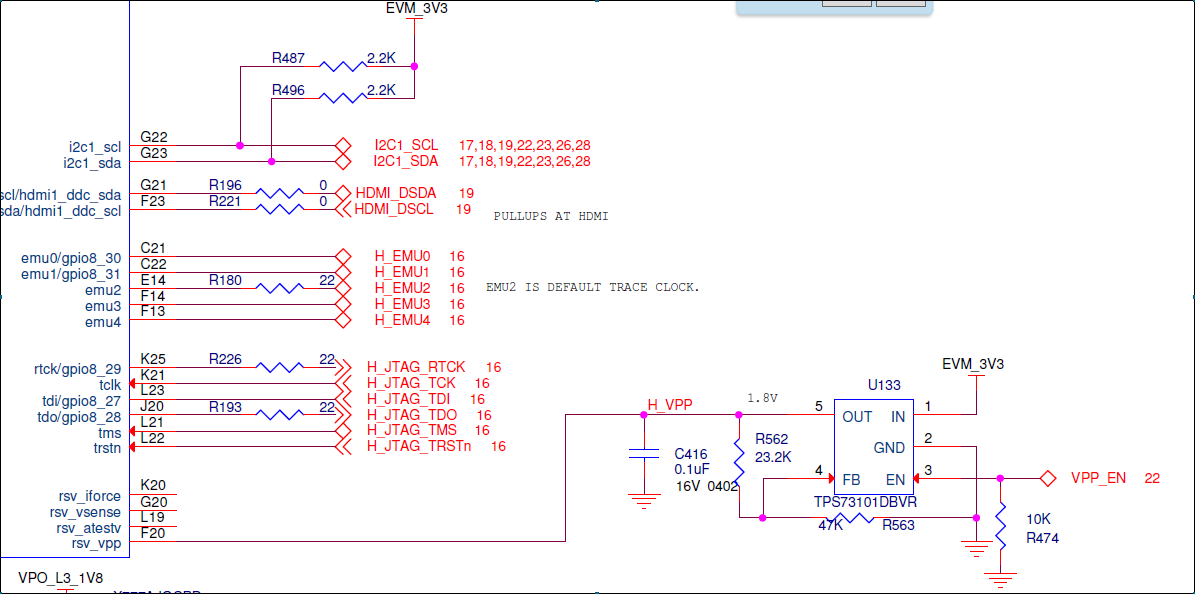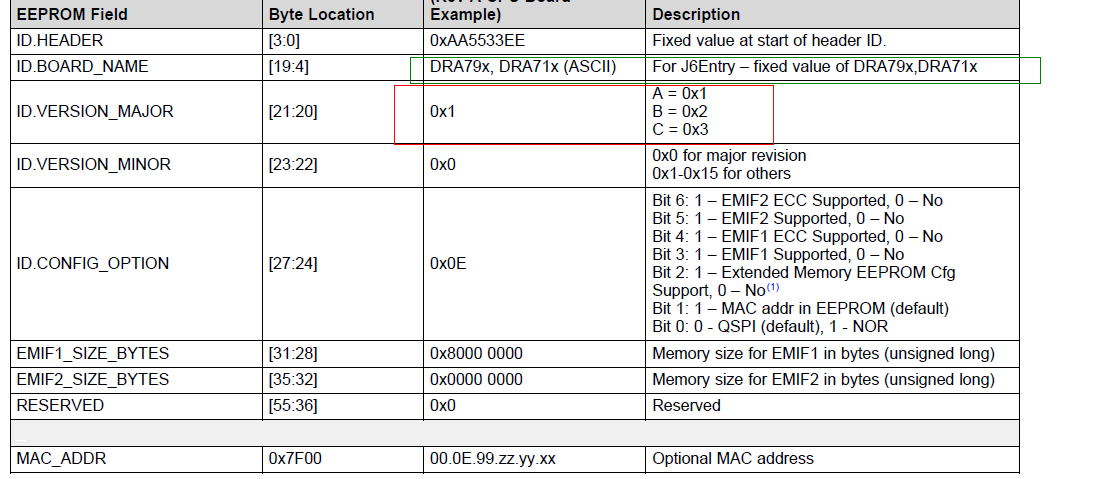Part Number: TDA2EX17EVM
Tool/software: TI C/C++ Compiler
Hi,
I encountered a strange problem today. I was debugging my own 913 yuv camera. I used vsdk308 for development and used sd to start. When I start, I start the app.out program, and the following message is prompted:
[08:17:55] [HOST] [HOST ] 78.151497 s:
[08:17:55] [HOST] [IPU2 ] 78.151711 s: CHAINS: ChainsCommon_MultiCam_StartCaptureDevice
[08:17:55] [HOST] [IPU2 ] 78.151863 s: numDev=28
[08:17:55] [HOST] [IPU2 ] 78.151924 s: BOARD_MAX_DEVICE=29
[08:17:55] [HOST] [IPU2 ] 78.152412 s: VIDEO_SENSOR: INST1 : I2C4 : I2C Addr = 0x38
[08:17:55] [HOST] [IPU2 ] 78.901146 s: src/bsp_deviceI2c.c @ Line 386:
[08:17:55] [HOST] [IPU2 ] 78.901268 s: I2C4: DEV 0x74: RD 0x01 ... ERROR !!!
[08:17:55] [HOST] [IPU2 ] 78.901360 s: src/bsp_deviceI2c.c @ Line 412:
[08:17:55] [HOST] [IPU2 ] 78.901421 s: I2C4: Error timeout 649 ms!!!
[08:17:55] [HOST] [IPU2 ] 78.901512 s: src/bsputils_lvds.c @ Line 1126:
[08:17:55] [HOST] [IPU2 ] 78.901604 s: device address - 74 i2c error - -21
[08:17:55] [HOST] [IPU2 ] 78.906453 s: VIDEO_SENSOR: VIP 2: DRV ID 121b (I2C ADDR 0x38): 0c31:0bed:0043
[08:17:55] [HOST] [IPU2 ] 78.907002 s: VIDEO_SENSOR: INST2 : I2C4 : I2C Addr = 0x39
[08:17:56] [HOST] [IPU2 ] 79.665314 s: src/bsp_deviceI2c.c @ Line 386:
[08:17:56] [HOST] [IPU2 ] 79.665436 s: I2C4: DEV 0x75: RD 0x01 ... ERROR !!!
[08:17:56] [HOST] [IPU2 ] 79.665527 s: src/bsp_deviceI2c.c @ Line 412:
[08:17:56] [HOST] [IPU2 ] 79.665619 s: I2C4: Error timeout 658 ms!!!
[08:17:56] [HOST] [IPU2 ] 79.665680 s: src/bsputils_lvds.c @ Line 1126:
[08:17:56] [HOST] [IPU2 ] 79.665771 s: device address - 75 i2c error - -21
[08:17:56] [HOST] [IPU2 ] 79.670499 s: VIDEO_SENSOR: VIP 0: DRV ID 121b (I2C ADDR 0x39): 0c31:0bed:0043
[08:17:56] [HOST] [IPU2 ] 79.671048 s: VIDEO_SENSOR: INST4 : I2C4 : I2C Addr = 0x3b
[08:17:57] [HOST] [IPU2 ] 80.402061 s: src/bsp_deviceI2c.c @ Line 386:
[08:17:57] [HOST] [IPU2 ] 80.402214 s: I2C4: DEV 0x77: RD 0x01 ... ERROR !!!
[08:17:57] [HOST] [IPU2 ] 80.402305 s: src/bsp_deviceI2c.c @ Line 412:
[08:17:57] [HOST] [IPU2 ] 80.402397 s: I2C4: Error timeout 630 ms!!!
[08:17:57] [HOST] [IPU2 ] 80.402488 s: src/bsputils_lvds.c @ Line 1126:
[08:17:57] [HOST] [IPU2 ] 80.402549 s: device address - 77 i2c error - -21
[08:17:57] [HOST] [IPU2 ] 80.407521 s: VIDEO_SENSOR: VIP 3: DRV ID 121b (I2C ADDR 0x3b): 0c31:0bed:0043
[08:17:57] [HOST] [IPU2 ] 80.408070 s: VIDEO_SENSOR: INST5 : I2C4 : I2C Addr = 0x3c
[08:17:58] [HOST] [IPU2 ] 81.139632 s: src/bsp_deviceI2c.c @ Line 386:
[08:17:58] [HOST] [IPU2 ] 81.139724 s: I2C4: DEV 0x78: RD 0x01 ... ERROR !!!
[08:17:58] [HOST] [IPU2 ] 81.139846 s: src/bsp_deviceI2c.c @ Line 412:
[08:17:58] [HOST] [IPU2 ] 81.139907 s: I2C4: Error timeout 632 ms!!!
[08:17:58] [HOST] [IPU2 ] 81.139998 s: src/bsputils_lvds.c @ Line 1126:
[08:17:58] [HOST] [IPU2 ] 81.140090 s: device address - 78 i2c error - -21
[08:17:58] [HOST] [IPU2 ] 81.145519 s: VIDEO_SENSOR: VIP 1: DRV ID 121b (I2C ADDR 0x3c): 0c31:0bed:0043
[08:17:59] [HOST] [IPU2 ] 82.150735 s: CAPTURE: Create in progress !!!
[08:17:59] [HOST] [IPU2 ] 82.151101 s: CAPTURE: VIP1 Slice1 PortA capture mode is [ 8-bit] !!!
[08:17:59] [HOST] [IPU2 ] 82.272250 s: CAPTURE: VIP1 Slice0 PortA capture mode is [ 8-bit] !!!
[08:17:59] [HOST] [IPU2 ] 82.393369 s: CAPTURE: VIP1 Slice1 PortB capture mode is [ 8-bit] !!!
[08:17:59] [HOST] [IPU2 ] 82.514487 s: CAPTURE: VIP1 Slice0 PortB capture mode is [ 8-bit] !!!
[08:17:59] [HOST] [IPU2 ] 82.635728 s: CAPTURE: Create Done !!!
[08:17:59] [HOST] [IPU2 ] 82.636216 s: IPC_OUT_0 : Create in progress !!!
[08:17:59] [HOST] [HOST ] 82.636826 s: IPC_IN_0 : Create in progress !!!
[08:17:59] [HOST] [HOST ] 82.637467 s: IPC_IN_0 : Create Done !!!
[08:17:59] [HOST] [HOST ] 82.637833 s: SGXFRMCPY: Create in progress for resolution: 1280x720 !!!
[08:17:59] [HOST] [HOST ] 82.637924 s: SYSTEM_PVRSCOPE: FIFO /opt/vision_sdk/gpufifo opened successfully
[08:17:59] [HOST] [IPU2 ] 82.636552 s: IPC_OUT_0 : Create Done !!!
[08:17:59] [HOST] [HOST ] 82.710760 s: EGL: version 1.4
[08:17:59] [HOST] [HOST ] 82.728634 s: EGL: GL Version = (null)
[08:17:59] [HOST] [HOST ] 82.728664 s: EGL: GL Vendor = (null)
[08:17:59] [HOST] [HOST ] 82.728664 s: EGL: GL Renderer = (null)
[08:17:59] [HOST] [HOST ] 82.728664 s: EGL: GL Extensions = (null)
[08:17:59] [HOST] [HOST ] 82.788995 s: SGXFRMCPY: Create Done for resolution: 1280x720 !!!
[08:17:59] [HOST] [HOST ] 82.789117 s: IPC_OUT_0 : Create in progress !!!
[08:17:59] [HOST] [HOST ] 82.789117 s: IPC_OUT_0 : Create Done !!!
[08:17:59] [HOST] [IPU2 ] 82.789300 s: IPC_IN_0 : Create in progress !!!
[08:17:59] [HOST] [IPU2 ] 82.790459 s: IPC_IN_0 : Create Done !!!
[08:17:59] [HOST] [IPU2 ] 82.790855 s: DISPLAY: Create in progress !!!
[08:17:59] [HOST] [IPU2 ] 82.791435 s: DISPLAY: Create Done !!!
[08:17:59] [HOST] [IPU2 ] 82.791801 s: GRPXSRC: Create in progress !!!
[08:18:00] [HOST] [IPU2 ] 83.426798 s: GRPXSRC: Create Done !!!
[08:18:00] [HOST] [IPU2 ] 83.427286 s: DISPLAY: Create in progress !!!
[08:18:00] [HOST] [IPU2 ] 83.427804 s: DISPLAY: Create Done !!!
[08:18:00] [HOST] [IPU2 ] 83.428475 s: *** UTILS: CPU KHz = 20000 Khz ***
[08:18:00] [HOST] [DSP1 ] 83.528487 s: SYSTEM: SW Message Box Msg Pool, Free Msg Count = 1023
[08:18:00] [HOST] [DSP1 ] 83.528518 s: SYSTEM: Heap = LOCAL_L2 @ 0x00800000, Total size = 227264 B (221 KB), Free size = 227264 B (221 KB)
[08:18:00] [HOST] [DSP1 ] 83.528548 s: SYSTEM: Heap = LOCAL_DDR @ 0x00000000, Total size = 524288 B (512 KB), Free size = 521592 B (509 KB)
[08:18:00] [HOST] [IPU2 ] 83.528823 s: SYSTEM: SW Message Box Msg Pool, Free Msg Count = 1023
[08:18:00] [HOST] [IPU2 ] 83.528975 s: SYSTEM: Heap = LOCAL_DDR @ 0x00000000, Total size = 262144 B (256 KB), Free size = 254048 B (248 KB)
[08:18:00] [HOST] [IPU2 ] 83.529128 s: SYSTEM: Heap = SR_OCMC @ 0x00000000, Total size = 0 B (0 KB), Free size = 0 B (0 KB)
[08:18:00] [HOST] [IPU2 ] 83.529311 s: SYSTEM: Heap = SR_DDR_CACHED @ 0x84203000, Total size = 262144000 B (250 MB), Free size = 212377600 B (202 MB)
[08:18:00] [HOST] [IPU2 ] 83.529494 s: SYSTEM: Heap = SR_DDR_NON_CACHED @ 0xa0100000, Total size = 1047040 B (0 MB), Free size = 1037824 B (0 MB)
[08:18:00] [HOST] [HOST ] 83.539224 s: SGXFRMCPY: Start in progress !!!
[08:18:00] [HOST] [HOST ] 83.539254 s: SGXFRMCPY: Start Done !!!
[08:18:00] [HOST] [IPU2 ] 83.530226 s: DISPLAY: Start in progress !!!
[08:18:00] [HOST] [IPU2 ] 83.530317 s: DISPLAY: Start Done !!!
[08:18:00] [HOST] [IPU2 ] 83.538644 s: DISPLAY: Start in progress !!!
[08:18:00] [HOST] [IPU2 ] 83.538736 s: DISPLAY: Start Done !!!
[08:18:00] [HOST] [IPU2 ] 83.539681 s: CAPTURE: Start in progress !!!
Then I power off, power on again, the serial port has no information.I replaced the rots system image, and it can start normally.The attached log is the last time I ran app.out on the linux system.
Why is this so? It just prompts that i2c fails to read and write, and then the sd firmware cannot be recognized normally. Start linux from sd



